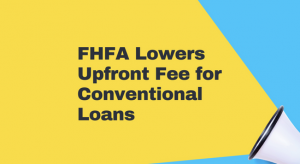The trucking industry is the backbone of American commerce, keeping goods moving across the country…
Federal Housing Finance Agency (FHFA) Lowers Upfront Fee for Conventional Loans
Conventional loans don’t have upfront mortgage insurance fees like government-backed loans (FHA) have, but there are fees behind the scenes many borrowers don’t realize.
You may not see the charge, but it’s wrapped into your interest rate, affecting your mortgage payment and affordability. For some borrowers, the difference of 0.25% of a rate can mean loan approval or denial.
For now, the FHFA claims they’re eliminating this fee for certain borrowers. Here’s what to expect.
What is the Conventional Loan Guarantee Fee?
The conventional loan guarantee fee is a fee to cover the cost of Fannie Mae and Freddie Mac guaranteeing conventional loans. This guarantee helps lenders offer more loans without requiring perfect credit or low debt-to-income ratios.
Lenders still have strict lending requirements for conventional loans to meet the Fannie Mae and Freddie Mac requirements, but the guarantee helps them be more flexible.
Who Pays It?
The guarantee fee isn’t something you’ll see itemized on your Loan Estimate because borrowers don’t pay it directly. Instead, lenders pay it to the GSE.
However, like most fees, lenders pass the GSE onto borrowers in the interest rate. In other words, they charge a higher interest rate to cover the cost of paying the guarantee fee.
So now, the FHFA is calling for the GSEs to eliminate the fee for certain borrowers.
Who Qualifies for the Eliminated Guarantee Fee?
The elimination of the guarantee fee only applies to certain borrowers, including the following:
Low-Income Families
The elimination of the guarantee fee first applies to families who make less than 100% of the area’s average median income. This number will be different in each county. It also applies to families who make less than 120% of the average median income in high-cost areas.
HomeReady and Home Possible Borrowers
HomeReady and Home Possible borrowers already have many advantages, including lower down payment requirements. Moving forward, they’ll also not be subject to guarantee fees which means the rates will be even lower for these borrowers.
HFA Advantage or HFA Preferred Borrowers
HFAs are loans offered by state and local housing agencies. These loans will also not have GSEs, making the rates even lower for borrowers.
Duty to Serve Program
The Duty to Serve Program helps low-income families afford manufactured housing or purchase rural homes.
How Does this Affect Homebuyers?
As we said earlier, borrowers won’t see their upfront fees decrease. The loan closing costs and cash needed to close will remain the same. However, it may lead to lower interest rates.
This can have multiple benefits:
- Lower monthly payments – The lower the interest rate lenders charge, the lower the monthly payment becomes. This is because borrowers pay back a portion of the principal each month, plus interest at the rate charged. Therefore, lower rates automatically lower the payment.
- Lower total costs – Saving even 0.25% on an interest rate can save a borrower thousands of dollars a year and tens of thousands of dollars over the loan’s term.
What about Cash-Out Refinances?
While the FHFA is lowering costs for first-time buyers with low income, they plan to increase the fees for existing homeowners who want a cash-out refinance.
The date and amount haven’t been disclosed yet, but February 2023 is the target date that could affect the cost of cash-out refinances. The FHFA states this is to minimize market disruption. However, the National Association of Mortgage Brokers has pleaded with the FHFA to rethink its decision.





